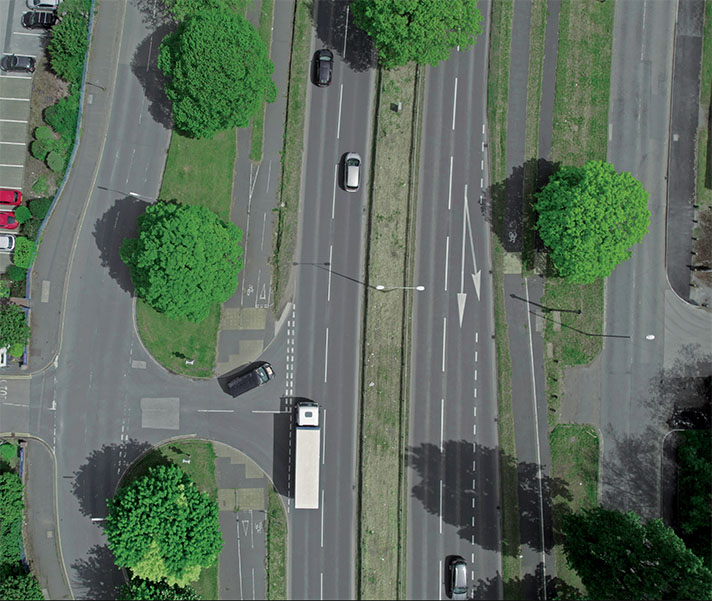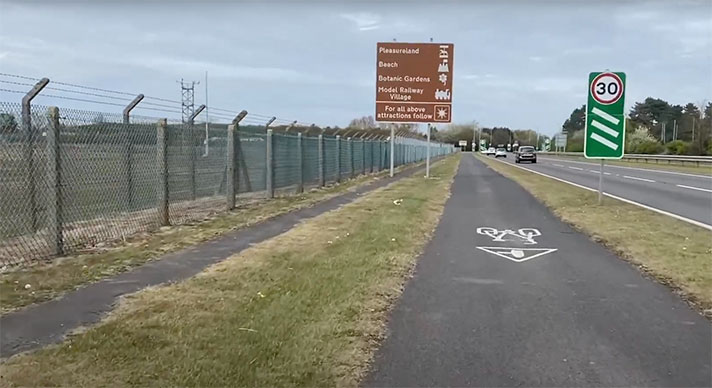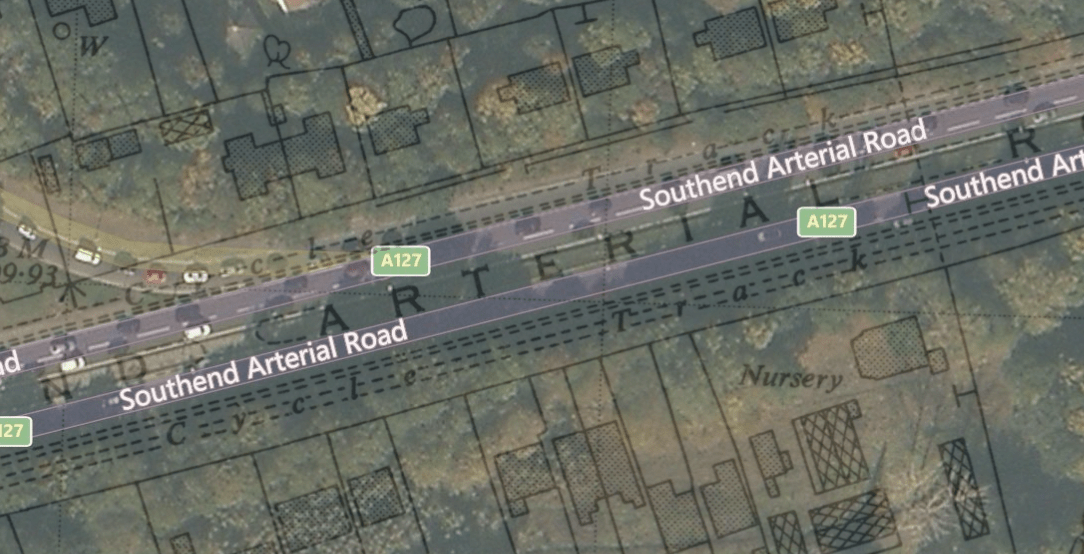
Mash-up of large-scale OS map of Southend Arterial Road and Google Maps.
“Here is the Southend Arterial Road on a wet day,” intones the snarky narrator of a police road safety film released in 1947.
“Cycle tracks are provided for the safety of cyclists,” he continued. “Do they use them? No, they prefer to pedal along serenely risking a serious accident from a chance skid on a greasy road.”
In fact, most of the cyclists in the shot – it looks like a CTC-style club run – are quite clearly using the cycle track.
The Southend Arterial Road – from Gallows Corner in Romford to the start of Princes Avenue on the outskirts of Southend – was retrofitted with a 20-mile cycle track, sometimes on both sides of the road, in about 1938.
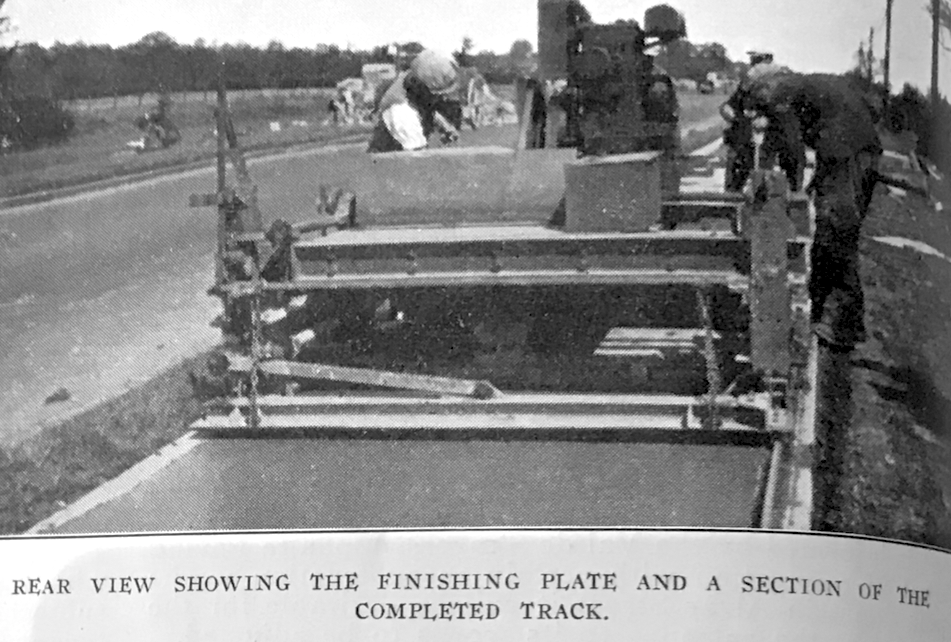
Workmen using an Allam Vibro Finisher to level concrete on cycle track on the Southend Arterial Road, 1937.
Retrofitted because the Southend Arterial Road had been built 13 years previously.
The road, and the Eastern Avenue from which it starts, were built as a single project, starting in 1921. Both roads were officially opened by Prince Henry (later the Duke of Gloucester) on 25 March 1925.
(Like his more famous brother, the prince suffered from a speech impediment — he was unable to pronounce the letter “r,” causing the intended letter to sound like “w.” Therefore, in his opening speech, Prince Henry praised the “new woad,” although obviously and tactfully that’s not how the press reported it at the time.)
Six years after it was opened as a single carriageway road the MoT started to plan to introduce both a second carriageway and footways on each side of the road.
Within another four years the idea to provide footways had been supplemented with the additional provision of cycle tracks.
“I have discussed the question of cycle tracks in Essex with the County Surveyor, and have urged him to put these in hand on the Southend Road, Eastern Avenue and on the East Ham and Barking By-pass,” wrote London’s divisional road engineer H. E. Dedington to the MoT’s chief engineer Colonel Bressey in August 1935.
“Provision for the second carriageway on the whole length of the London-Southend Road between Harold Wood Station and the Southend boundary is included in the Five Years Programme of Essex County Council,” added Dedington, saying that the council intended to “commence this work during the financial year 1936/1937.”
“Cycle tracks will be constructed throughout,” confirmed Minister of Transport Leslie Hore-Belisha to parliament in February 1937, stating that the council “expect to complete the first four miles from Gallows Corner by the end of next month.”
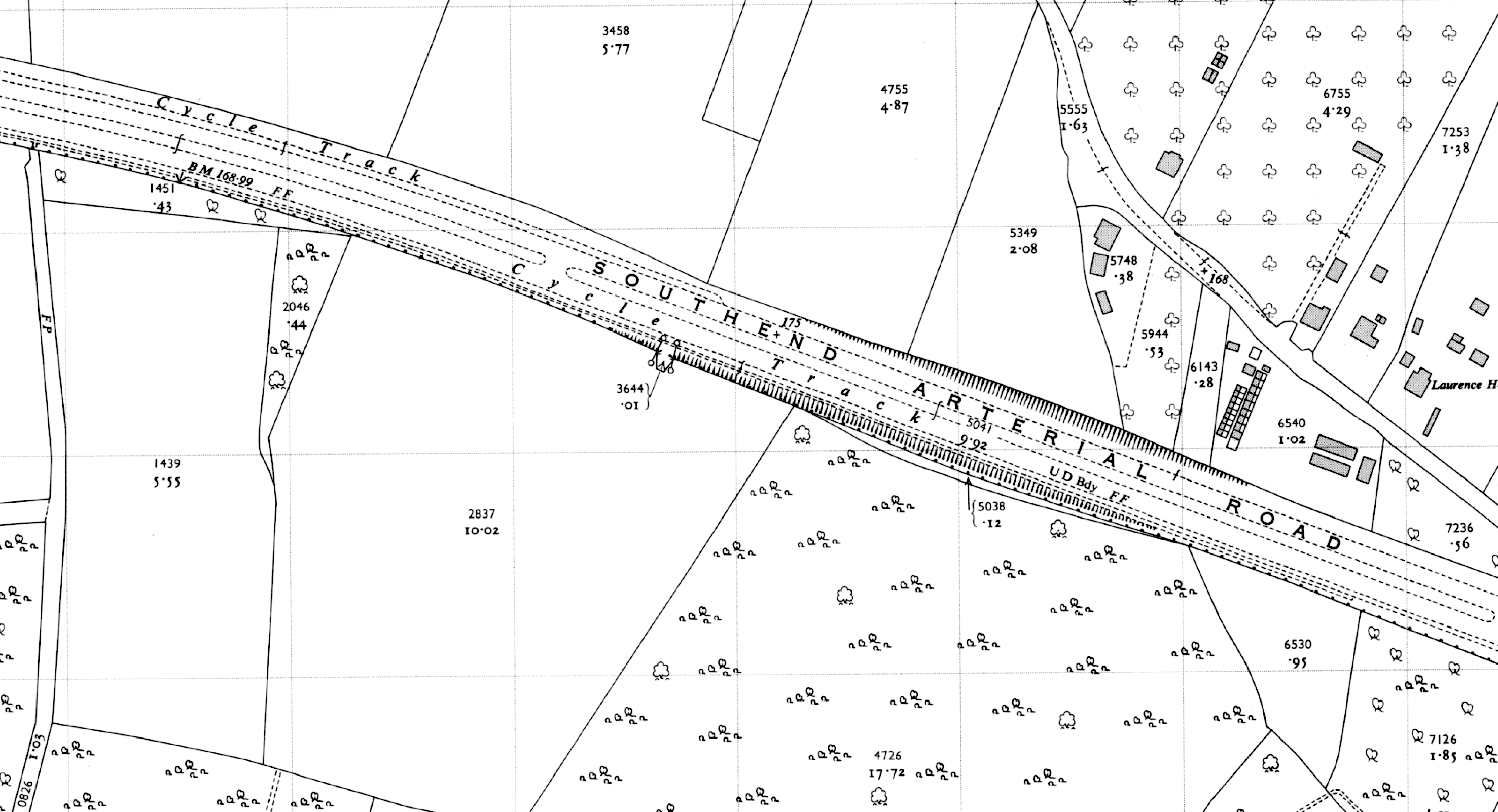
OS map showing cycle tracks on the Southend Arterial Road.
A correspondent for The Bicycle weekly paper noted that the “first part of the scheme is concerned with the section, about 6,300 yards long, between Squirrels Heath-road and Great Warley-road.” In a reply to a period information request about cycle track building from the American Embassy, the Ministry of Transport said that the first four miles of the Southend Arterial Road’s cycle tracks would be 9ft wide and surfaced with concrete and “consolidated hoggin.”
(“Hoggin” is a Thames Valley term for fine binding flint gravel, said the MoT letter.)
The first few miles of the cycle tracks on the Southend Arterial Road were, indeed, surfaced with concrete, confirmed a construction trade magazine in 1937:
“We have recently had an opportunity of inspecting the cycle track which has now been completed on the south side of the road for distance of approximately six miles,” reported Roads and Road Construction.
“The track is of concrete construction and the concrete has been placed by a vibro finisher supplied by E. P. Allam & Co. Ltd. 6, Great James Street, London.”
The magazine also revealed a difference between the tracks on each side of the road. There were “two cycle tracks, one 6ft. in width on the south side, and one 9 ft. in width on the north side of the road.”
An article in the Birmingham Post added that a “new footpath six feet wide will also be provided.”
The article estimated that the full length of the road, “a distance of about eighteen and a half miles,” would be completed by the end of summer in 1940 for “work is proceeding on the final section, more than ten miles long.”
A 1949 aerial photograph of the Laindon section of the road shows the two carriageways and the cycle tracks snaking off into the distance.
That the cycle track was in use at this point soon after it was constructed is shown by press mentions such as a 1938 report about a cyclist fined for being drunk in charge of a bicycle and who “went off the cycle track on to the road” near Laindon. And in the following year an RAC Scout on a motorcycle was fined for not paying attention at a garage turn-in and nearly running into East Ham butcher Mr. B. Bull and his wife, who were “tandem cycling along the cycle track at the side of the arterial road.”
Many long stretches of the period cycle track still exist although some key sections have been extinguished by later remodellings, especially at junctions.
BASILDON
The tracks on the Southend Arterial Road once meshed with the rudimentary “cycleway” network of the New Town of Basildon built, controversially, after 1949. Basildon had 4.5 miles of “partially separated” cycleways by the 1960s, said a contemporary study. The cycleways were not as extensive as the dense network of grade-separated cycleways built in the New Town of Stevenage in the same period.
“Basildon will become a city which people from all over the world will want to visit,” predicted Lewis Silkin, Clement Atlee’s Minister of Town and Country Planning in front of a large, rowdy gathering at High Road School, Laindon, on 30 September 1948.


